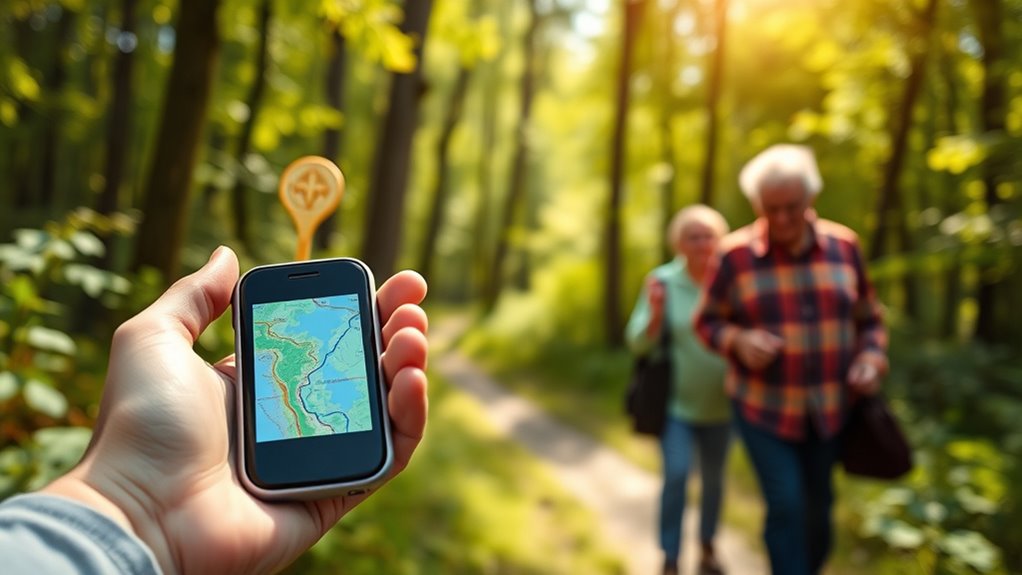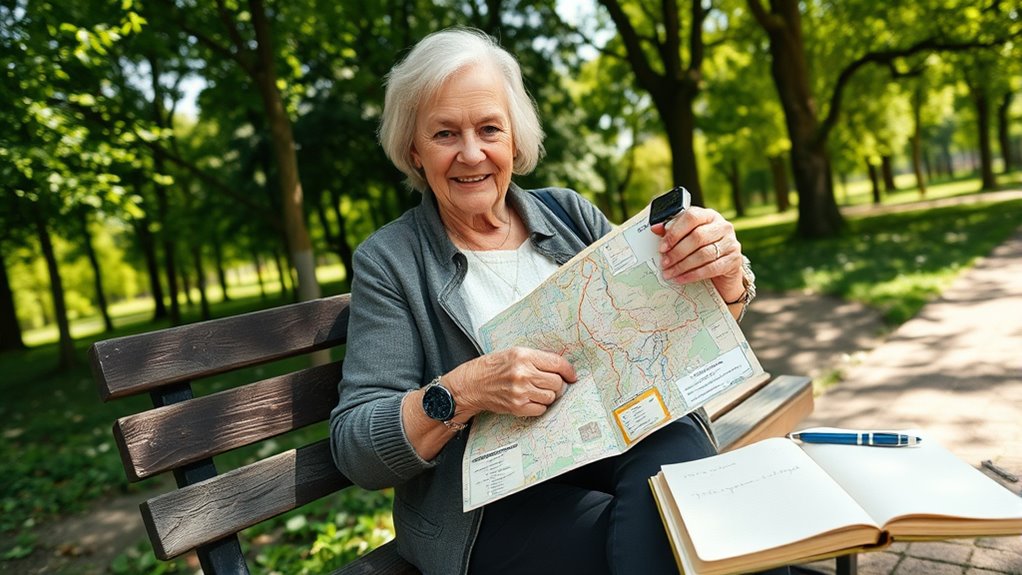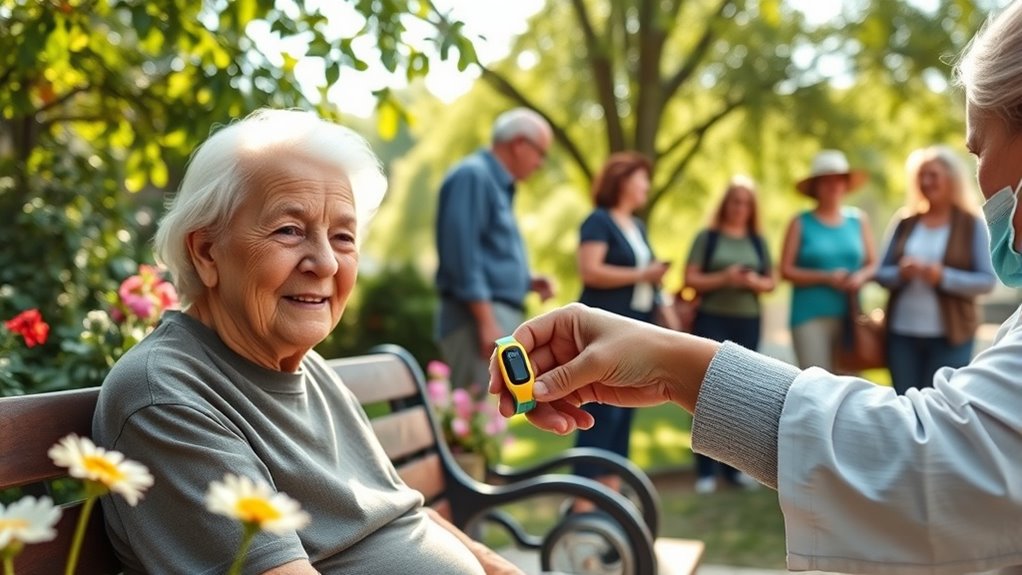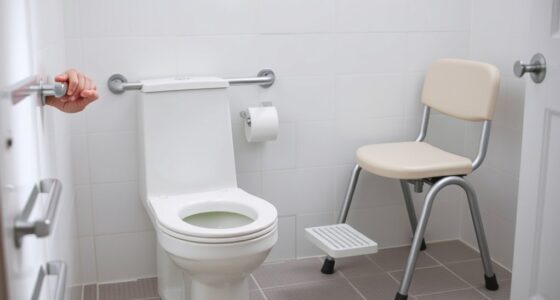To monitor wandering, you can combine GPS devices with non-tech strategies like controlling access points, establishing routines, and removing hazards to create a safer environment. Engage community resources and coordinate with local agencies for added support. You might also consider visual cues, personal reassurance, and maintaining updated information about your loved one. Want to learn how these approaches work together and how you can best implement them? Keep exploring to find helpful tips and solutions.
Key Takeaways
- GPS devices provide real-time location tracking, alerts, and geofencing to monitor individuals who wander.
- Environmental safety measures like locks, barriers, and routine schedules reduce wandering risks without technology.
- Community engagement involves training neighbors and local groups to recognize wandering and respond effectively.
- Combining GPS technology with regular check-ins and personal reassurance strategies enhances safety.
- Caregivers can prepare by maintaining updated photos, establishing routines, and fostering communication with support networks.
Understanding Wandering and Its Impact

Understanding wandering is crucial because it can pose serious safety risks for individuals with cognitive impairments, such as dementia or Alzheimer’s disease. When someone wanders, they may leave familiar surroundings and become lost or injured. It can happen suddenly and often without warning, making it difficult for caregivers to predict or prevent. Wandering can lead to dehydration, falls, or exposure to dangerous environments. It also causes emotional distress for both the individual and their loved ones. Recognizing why wandering occurs helps you better understand its impact. It’s often driven by confusion, curiosity, or the need for comfort. By understanding these underlying factors, you can take proactive steps to manage the behavior and ensure safety, reducing anxiety and potential harm. Additionally, high contrast ratios in visual cues and environments can support individuals with cognitive impairments by making important signals more distinguishable, thereby reducing confusion. Incorporating environmental considerations such as safe, accessible outdoor spaces can also help reduce the likelihood of wandering and promote a sense of security.
How GPS Devices Assist in Monitoring

GPS devices help you keep track of loved ones by providing real-time location updates. They also send emergency alerts if needed and let you set safe zones with geofencing boundaries. These features make monitoring more reliable and give you peace of mind. Best GPS devices are designed to ensure accuracy and user-friendly operation. Incorporating accurate tracking technology can further enhance monitoring capabilities and reliability. Additionally, choosing devices with long-lasting battery life ensures continuous monitoring without frequent recharging. A focus on reliable signal transmission is essential for maintaining consistent tracking performance.
Real-Time Location Tracking
Real-time location tracking has become a vital tool in monitoring individuals who may wander, offering immediate updates on their whereabouts. This technology allows you to stay informed and respond quickly if someone goes off-course. With real-time tracking, you can:
- Receive instant location updates via a connected device or app.
- Track movement history to identify patterns or areas of concern.
- Set geofences that alert you when the person leaves a designated safe zone.
These features help you act swiftly, reducing the risk of harm and providing peace of mind. Real-time tracking is especially valuable in unfamiliar environments or crowded settings, ensuring you can locate loved ones promptly. It’s an effective way to enhance safety without constant physical supervision.
Emergency Alert Features
Emergency alert features are critical tools that enable you to receive immediate notifications if a person needs help or has entered a risky situation. When a device detects unusual movement, such as wandering into unsafe areas or prolonged inactivity, it can automatically send alerts to your phone or designated contacts. Some devices allow you to manually trigger alerts with a simple button press, giving you quick access to emergency assistance. These alerts often include the person’s real-time location, making it easier to respond swiftly. By integrating GPS technology, emergency features ensure you’re promptly informed of potential dangers, reducing response times and increasing safety. This proactive approach helps you stay connected and prepared, giving peace of mind knowing help can be summoned instantly when needed.
Geofencing Boundaries
Geofencing boundaries are a powerful tool that allows you to set safe zones for a loved one and receive alerts if they leave those areas. You can define specific locations, such as home, a park, or a caregiver’s center, creating a virtual perimeter. When your loved one crosses these boundaries, you’ll get instant notifications, helping you respond quickly. To make the most of geofencing, consider these key points:
- Choose appropriate safe zones based on daily routines and needs.
- Regularly update boundaries if your loved one’s location or routines change.
- Use alerts wisely, balancing safety with privacy to avoid unnecessary notifications.
Limitations of Technology-Based Solutions

While technology offers valuable tools for monitoring wandering, it has notable limitations that can hinder effectiveness. Devices like GPS trackers depend on battery life, and if the battery dies, monitoring stops. Signal loss indoors or in densely built areas can result in inaccurate or missed location updates. Privacy concerns may make some individuals resistant to wearing tracking devices, reducing their usefulness. Technical glitches, such as false alarms or device malfunctions, can cause unnecessary stress or delay responses. Additionally, technology doesn’t address the underlying reasons for wandering or provide emotional support, which are indispensable for long-term safety. Relying solely on tech can give a false sense of security, overlooking the importance of human oversight and personalized care.
Creating a Safe and Supportive Environment

Creating a safe and supportive environment is essential for reducing wandering risks and promoting calmness. You can achieve this by making simple adjustments that help individuals feel secure and comfortable. First, control access points to prevent accidental escapes by installing locks or barriers. Second, create familiar routines and consistent daily schedules to reduce anxiety and confusion. Third, remove hazards and clutter that could cause falls or injuries. These steps foster a sense of stability and safety, decreasing the likelihood of wandering. Additionally, maintaining a calm atmosphere and using gentle communication can help reduce agitation. Implementing privacy policies to protect personal information can also contribute to a sense of trust and security. By prioritizing these strategies, you create an environment that supports well-being and minimizes risks associated with wandering.
Personal Strategies for Managing Wandering

Managing wandering effectively often requires personalized strategies that caregivers and family members can implement directly. Start by establishing a routine, as predictability can reduce anxiety and the urge to wander. Keep doors and windows secured or use visual cues to remind your loved one of boundaries. Engage them in daily activities that are stimulating and meaningful to reduce restlessness. Clear communication is essential—use simple language and gentle reassurance. Maintain a calm environment to prevent agitation. If your loved one tends to wander at specific times, plan activities or outings during those periods to minimize risk. Regular supervision and staying alert are key. Incorporating Glycolic acid benefits in skincare routines can improve skin texture, which may help in boosting confidence and reducing agitation caused by skin concerns. By customizing these approaches, you create a safer space and help manage wandering behavior proactively and compassionately.
Engaging Community Resources and Support Networks

Getting your community involved can make a big difference in monitoring wandering. You can recruit volunteers, partner with local agencies, and build support networks to stay alert and responsive. These connections help create a safety net that keeps your loved one safer and more supported. Additionally, understanding decoding slang can improve communication within your support network, ensuring everyone stays informed and responsive. Knowing about vetted safety products and proper procedures can further enhance your community’s ability to respond quickly in emergencies. Building awareness of water-efficient and environmentally friendly approaches can also promote sustainable practices in your community efforts. Incorporating community training programs can empower volunteers and caregivers with essential skills, strengthening the overall safety system. Engaging with tableware in community settings can foster social connections and support inclusive activities that benefit all members.
Community Volunteer Engagement
Engaging community volunteers is an essential component of effective wandering prevention strategies. Volunteers can provide immediate support, increase supervision, and create a sense of community safety. To maximize their impact, consider these approaches:
- Recruit local residents, neighbors, and faith-based groups to serve as watchful eyes.
- Offer training that helps volunteers recognize wandering signs and respond appropriately.
- Establish clear communication channels so volunteers can relay concerns or sightings quickly.
Partnering With Local Agencies
Building strong partnerships with local agencies expands your community’s capacity to prevent wandering and respond effectively when it occurs. Collaborate with law enforcement, emergency services, and healthcare providers to create a coordinated response plan. These agencies can offer valuable resources, training, and quick response when needed. Establish regular communication channels to share updates and concerns. Use the table below to identify key partners and their roles:
| Agency | Role |
|---|---|
| Local Police Department | Emergency response, search and rescue |
| Healthcare Providers | Medical support, resident health monitoring |
| Community Organizations | Outreach, caregiver education, resource sharing |
Building Support Networks
Strengthening support networks involves actively connecting with community resources and fostering relationships that can assist in preventing wandering incidents. By building these connections, you create a safety net that responds quickly when needed. To do this effectively, consider these steps:
- Reach out to local organizations, such as senior centers or mental health groups, to share information about your loved one’s needs.
- Engage neighbors and community members to increase vigilance and create a sense of shared responsibility.
- Collaborate with local authorities and emergency services to establish clear communication channels.
These steps help you create a robust support system that enhances safety and provides peace of mind, ensuring help is available when wandering occurs. Building these relationships is key to a all-encompassing safety approach.
Combining Tech and Non-Tech Approaches for Better Outcomes

Combining technology with non-tech approaches offers a more all-encompassing strategy for monitoring wandering. By integrating GPS devices, motion sensors, and apps with regular check-ins and environmental modifications, you create a layered safety net. This combination increases the chances of timely intervention and reduces stress for both you and your loved one. Imagine a system where a GPS collar alerts you if wandering occurs, while a caregiver calls to confirm safety. Visualize this table representing the synergy:
| Tech Tools | Non-Tech Strategies |
|---|---|
| GPS tracking devices | Regular caregiver visits |
| Motion sensors | Environmental safety measures |
| Smartphone apps | Routine and activity schedules |
| Electronic fences | Family support networks |
| Emergency alerts | Personal reassurance efforts |
Tips for Caregivers Navigating Wandering Behaviors

Wandering can be unpredictable and stressful for caregivers, but staying calm and prepared makes a significant difference. Your approach can help keep everyone safe and reduce anxiety. First, establish a routine to provide stability and predictability. Second, keep a current photo and a list of favorite places or familiar routes handy, in case you need to alert others or help with search efforts. Third, communicate openly with family, friends, and neighbors about your loved one’s wandering tendencies, so they can assist if needed. Staying observant and proactive helps you respond quickly and effectively. Remember to prioritize your own well-being too—take breaks and seek support when necessary. Being organized and informed empowers you to handle wandering behaviors confidently.
Frequently Asked Questions
How Can Family Members Effectively Communicate About Wandering Concerns?
You can effectively communicate your wandering concerns by choosing a calm, supportive tone and listening carefully to your loved one’s perspective. Share specific examples and express your feelings honestly without blame. Use “I” statements to focus on safety and reassurance. Encourage open dialogue, ask questions, and show understanding. Together, you can develop a plan that respects their independence while addressing safety worries, fostering trust and cooperation.
What Legal Considerations Exist Around Non-Tech Monitoring Methods?
When considering non-tech monitoring methods, you should be aware of legal considerations like respecting privacy rights and obtaining consent. Laws vary by location, so make certain you’re compliant with local regulations. If the person with dementia can give informed consent, it’s best to involve them in the decision. Always document your actions, and avoid invasive measures that could violate their rights or lead to legal issues.
How Do Cultural Differences Influence Wandering Management Strategies?
Cultural differences considerably shape wandering management strategies. You might find that in some cultures, independence and exploration are highly valued, leading to more permissive approaches. In others, safety and family involvement take precedence, resulting in stricter controls. It’s essential that you respect these cultural norms and beliefs, adapting your strategies accordingly. By understanding and honoring these differences, you can create more effective, respectful plans that align with individuals’ cultural backgrounds.
Are There Specific Training Programs for Caregivers on Non-Tech Approaches?
Oh, sure, because everyone just naturally wakes up one day knowing how to handle wandering without tech! You can find training programs designed specifically for caregivers, focusing on non-tech approaches like environmental modifications, validation, and reassurance. These programs teach you patience, observation, and gentle redirection—skills that don’t come from gadgets but from understanding and compassion. So, yes, you can get trained, and it’s often the most heartfelt approach.
How to Handle Wandering Episodes During Nighttime or in Unfamiliar Areas?
When handling wandering episodes at night or in unfamiliar areas, stay calm and gently guide your loved one back to a safe space. Keep the environment secure by removing hazards and using familiar scents or objects to comfort them. Establish a consistent bedtime routine, and consider using visual cues or landmarks to help orient them. Always supervise closely, and if needed, seek assistance from caregivers or local authorities to guarantee safety.
Conclusion
Think of managing wandering as tending a garden—you need a mix of tools, patience, and understanding. Combining GPS tech with non-tech strategies creates a strong safety net, like sturdy trellises supporting your plants. By blending these approaches, you help your loved one thrive in a safe, nurturing environment. Remember, you’re the gardener guiding growth, using every resource to guarantee their well-being blossoms with confidence and care.









